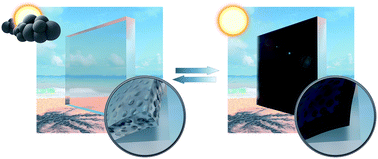Highly transparent photochromic films with a tunable and fast solution-like response†
Abstract
The increasing interest towards photochromic films and their practical applications is driving researchers in the continuous design and synthesis of novel organic photochromic dyes with optimized performances in polymeric matrices. However, whereas their photochromic properties could be readily rationalized in organic liquid solutions, these could not be directly extrapolated to polymers as their performance changes unpredictably upon integration into a solid matrix. This leads to a time-consuming synthetic re-tuning of the dye chemical structure and/or the polymeric medium. To avoid this, herein we report an efficient, straightforward and universal strategy to embed commercial T-type organic photochromic dyes of different nature in a polymeric material without compromising their optimum solution absorption and isomerization kinetics. Our approach is based on trapping emulsified nanodroplets of a hydrophobic solution enclosing the dye into a hydrophilic polymeric matrix. The material is prepared through one single process using commercially available materials, without further modification of the components (the dye and the polymer matrix) nor requiring previous encapsulation steps. The films, which manifest true solution liquid-like and finely tunable photochromic behavior, are also highly transparent, recyclable, and scalable, and show enhanced fatigue resistance, making them highly suitable for different smart glass applications.



 Please wait while we load your content...
Please wait while we load your content...